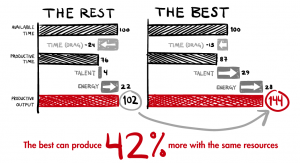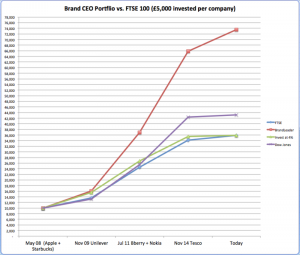“In an age of abundant capital, your most precious assets are your organisation’s time, talent and energy,” according to a HBR article by Bain which grabbed my attention. The article is very much in line with our belief in focusing people on the growth opportunities with the best chance of success: we call this maximising ‘return on talent’. This often involves re-focusing time, talent and energy on the core business, as covered in this post on the rise, fall and revival of Tesco. Bain have come up with a model to help you improve “productive power” of your business that I discuss below. It looks at available time less ‘drag’ from inefficiency plus the positive effects of the right talent and energy.

1. Reduce ‘organisational drag’
The first way to improve productive power is to save time wasted through meetings, bloody meetings. Managers are spending more time than ever in meetings, partly because its easier and cheaper to take part via phone and videoconferencing. Bain estimate that 15% of an organization’s collective time is spent in meetings and that this percentage has gone up every year since 2008. In an earlier post here we suggested a number of ways to make meetings more efficient, including setting clear objectives, limiting the invite list (based on added value and importance for alignment/engagement), having the right pre-read and being ruthless about start/end time.
2. Focus, focus, focus
The second key driver of organisational performance is having the right people focused on the right priorities. Many of the cases of brand turnaround we have seen first-hand involved a leader focusing people on fewer, bigger, better initiatives. Simon Clift told me how did this when he ran Unilever’s marketing team in Brazil, focusing budget and people on a couple of key brands including Sedal. And the Bain article talks about Steve Jobs’ approach at Apple. “Each year Jobs took Apple’s top 100 executives off-site for a planning retreat and pushed them to identify the top 10 priorities. Jobs took a marker and crossed out the bottom seven. This focus dramatically accelerated the pace of innovation at the company and helped it become one of the largest in the world.”
3. Energize your team
The third piece of the performance puzzle is energising the team. We see how this can work in our projects that help marketing leaders create a compelling vision for the brand to inspire and energize the whole business. I posted here about the power of “brand CEOs”: inspirational leaders who energize teams be being the living, breathing embodiment of their brands. We back our belief in brand leadership with hard cash, investing in companies where leaders we admire have taken over at critical times. These leaders include Howard Shultz returning as CEO of Starbucks, Paul Poleman taking over as CEO of Unilever and Dave Lewis joining troubled retailer Tesco. As the graph below shows, our Brand CEO portfolio out-performed the Dow Jones and FTSE stock market indexes.

In conclusion, companies should be as rigorous in assessing how to invest time, talent and energy as they are when allocating financial capital.
If you want to do a quick diagnostic of your organisation’s productive power, take the online test here.
